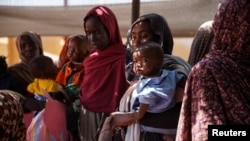Humanitarians said an international support conference next week for Sudan must be a success, as 18 million Sudanese face crisis levels of hunger while funding for lifesaving programs is running out.
“It is essential that we get the levels of funding that will allow us to scale [up] to the extent required,” Michael Dunford, World Food Program regional director for East Africa, told reporters from Nairobi.
On Monday, ministers will gather in Paris for a two-part conference co-hosted by the European Commission, France and Germany. There will be discussions on how to move toward a political solution to the conflict, and a separate meeting of humanitarians and international donors for a humanitarian conference for Sudan and its neighbors.
This will take place on the one-year anniversary of the outbreak of the civil war, which has seen food insecurity surge and millions displaced.
“As intense fighting continues, the humanitarian tragedy grows worse by the day,” Justin Brady, head of the U.N. office for humanitarian affairs in Sudan, told reporters from Port Sudan.
“Already, nearly 5 million people are one step away from famine,” he said. “Recent analysis indicates that famine is expected in parts of Khartoum and Greater Darfur – especially in hard-to-reach areas.”
Children are particularly affected, with an estimated 730,000 suffering from severe acute malnutrition. Brady said more than 200,000 children could die in the coming weeks and months if they do not receive urgent assistance.
Humanitarians are especially worried because these are record-high numbers during the harvest season, when food should be available and affordable. But because of the yearlong war between rival Sudanese generals, farmers and pastoralists have fled and their crops and cattle have withered, died or been destroyed.
The lean season will be upon Sudan in June, and then the number of people who are acutely food insecure will likely grow from the current 18 million people.
“This is why we are desperately concerned that the 5 million population in emergency levels of food insecurity are likely to move into catastrophic levels in the coming months,” said WFP’s Dunford. “This is really a very real risk of becoming the largest hunger crisis anywhere in the world — if not already.”
Despite dangers, bureaucratic difficulties, funding shortages and other constraints, Brady says humanitarians have reached more than 8 million people with aid since the war started.
That assistance is in jeopardy, though, as the U.N. humanitarian appeal for $2.7 billion is just under 6% funded. About $400 million is needed immediately so aid workers can pre-position supplies ahead of the lean season, and an additional $700 million to sustain the response in the coming months as humanitarians launch a famine prevention plan.
Neither of the warring parties is expected to be represented at the Paris conference, but members of Sudanese civil society have been invited to participate.
Sudan is now home to the world’s largest internal displacement crisis, with 6.3 million people forced from their homes in search of safety. Another 1.7 million have fled to neighboring countries. More than 70% of health facilities in conflict areas have stopped functioning.










